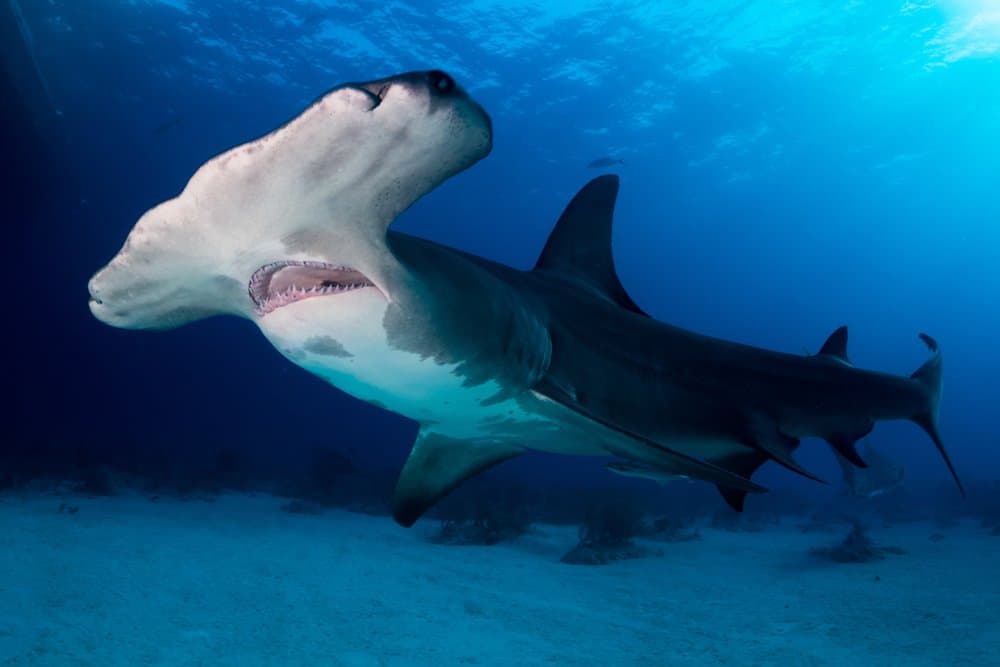
These results also show that the first hammerheads to evolve had large rather than small cephalofoils. zygaena) form a clade that is basal to all other Sphyrna species. Older studies based on morphology have generally placed the great hammerhead as one of the more derived members of its family, reflecting the traditional view that cephalofoil size gradually increased over the course of hammerhead shark evolution, but this view has been refuted by phylogenetic analyses using nuclear and mitochondrial DNA, which found that the great hammerhead and the smooth hammerhead ( S. The lectotype for this species is a 2.5-m-long (8.2 ft) male from the Red Sea. As the next-most senior synonym, Sphyrna mokarran became the great hammerhead's valid name. In 1950, Enrico Tortonese determined that the specimens illustrated by Valenciennes were in fact smalleye hammerheads, to which the name S. For many years, though, the valid scientific name for the great hammerhead was thought to be Sphyrna tudes, which was coined in 1822 by Achille Valenciennes.

The name was later changed to the current Sphyrna mokarran. The great hammerhead was first described as Zygaena mokarran in 1837 by German naturalist Eduard Rüppell. As a result, great hammerhead populations are declining substantially worldwide, and it has been assessed as critically endangered by the International Union for Conservation of Nature (IUCN) as of 2019.

This shark is heavily fished for its large fins, which are valuable on the Chinese market as the main ingredient of shark fin soup. This species has a viviparous mode of reproduction, bearing litters of up to 50 pups every two years.Īlthough potentially dangerous, the great hammerhead rarely attacks humans and can sometimes behave inquisitively toward divers. Observations of this species in the wild suggest that the cephalofoil functions to immobilize stingrays, a favored prey. A solitary, strong-swimming apex predator, the great hammerhead feeds on a wide variety of prey ranging from crustaceans and cephalopods, to bony fish, to smaller sharks. The great hammerhead can be distinguished from other hammerheads by the shape of its "hammer" (called the "cephalofoil"), which is wide with an almost straight front margin, and by its tall, sickle-shaped first dorsal fin. It is found in tropical and warm temperate waters worldwide, inhabiting coastal areas and the continental shelf. Great White Sharks spawn around Eruption Island, Shadow Isles, Monster's Borough and Port Jackson.The great hammerhead ( Sphyrna mokarran) or great hammerhead shark is the largest species of hammerhead shark, belonging to the family Sphyrnidae, attaining an average length of 4.6 m (15 ft) and reaching a maximum length of 6.1 m (20 ft). Players can find Sea Creatures easier by using the Creature Locator, which will point the player to the closest Sea Creature. Every Egg dropped can be placed in the players' Tier 2 Aquarium. However, Hammerhead Shark Eggs are a 0.1% chance every kill, which is a 1/1000 chance. Regular creature Egg drops are a 0.2% chance every kill, which is a 1/500 chance. The rarest drop Sea Creatures can typically drop is their associated Egg. The creature will typically target players rather than boats themselves, that's why you will sometimes see them stop chasing you and go for another player that fell off the boat. All Sea Creatures will attack when the player swims/drives close.

Sea Creatures are animals that spawn in the ocean.


 0 kommentar(er)
0 kommentar(er)
